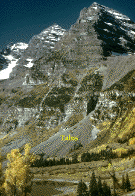
Introduction
-
When the gravitational force acting on a slope exceeds its resisting force, slope failure occurs (mass wasting). In less than two minutes 40 million cubic yards of rock from Turtle Mountain slid along a plane of structural weakness to cover the town of Frank, Alberta, Canada in 1903. The link in the Chapter Heading will take you to the National Landslide Information Center where you can read about this type of Mass Movement. As you read the text and this resource guide think about "early warning" signals that may accompany the movement of Earth materials.
- slope material's strength and cohesion
- amount of internal friction between grains
- any external support of the slope
The following factors help to determine the slope stability. Shear strength is a measure of the ability of an object to withstand a change in shape. For a slope the shear strength is a function of:
Gravity operates vertically but has components acting parallel to the slope and perpendicular to the slope. If the component parallel to the slope is the dominant component this helps cause instability.

The USGS has several useful links for those wishing to learn more about Landslides.
Major factors influencing the extent of mass wasting include:
- The slope gradient is probably a major cause of mass wasting - the steeper the slope the less stable it is.
- In regions that are undergoing extensive chemical weathering there is a higher probability of mass movement of the unconsolidated material (the regolith).
- The higher the water content the less stable the slope. Water may percolate into the material and decrease friction between the grains, which lowers the shear strength.
- Vegetation - vegetation can absorb water which can prevent water from percolating into the unconsolidated material. The root systems help to stabilize a slope.
- Overloading - additional weight created by overloading increases the water pressure which may decrease its shear strength.
- Geologic Features - If the rocks dip in the same direction as the slope, or if there are joints which dip in the direction of the slope, mass wasting is more likely - water can more easily percolate along the bedding planes and lower the cohesiveness and friction between grains.
Just about any force can trigger mass wasting.
Types of Mass Wasting
- Rate of Movement - rapid or slow
- Type of Movement - falling, sliding or flowing
- Type of Material involved - rock, soil or debris
What features would you look for to determine if the site where you wanted to build a house was safe. Consider all of the topics we have discussed in class - don't limit to mass wasting.
Would you expect the probability of mass wasting to be greater along a passive continental margin or an active continental margin? Why?
| jbutler@uh.edu
|ClassListserv
|Textbook Home Page
|Glossary of Geologic Terms|
|Search These Pages|Other Courses|Resources|Grade Book|
Copyright by John C. Butler, July 29, 1995